Alaska Economic Trends
Alaska Economic Trends is a monthly magazine that covers a range of economic topics.
Sign up for a free electronic subscription. 
Sign up for a paid print subscription.
Alaska Economic Trends are searchable from 1961 to the present using the Trends search page. The search can include any combination of the following: Key Words, Date Range, Author, Category
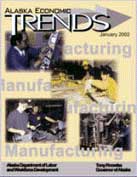
Manufacturing was once the industrial heart of America. The steel mills of Pittsburgh and the automobile factories of Detroit attracted large numbers of immigrants to high paying jobs?
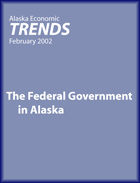
Ever since the purchase of Alaska from Russia in 1867, the federal government has been a heavy weight on Alaska's economic scene, and this is still true today.

The aging of Alaska's labor force has been well documented in Alaska Economic Trends and other sources. Alaska's population and economic trends of the past thirty years will have an impact on the state's economy for years to come. This article will review how Alaska's labor force became what it is today, and take a look at what might happen in the future.
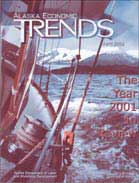
Year 2001 marked the thirteenth consecutive year of job growth in Alaska, the second longest period of expansion in the state's history. It was another good year for the oil industry, which recorded its second straight year of growth, adding another 1,000 jobs in 2001 after contributing 900 jobs to the state's economy in the year 2000. Construction was also strong, but the biggest portion of 2001's job growth was once again in the services sector.
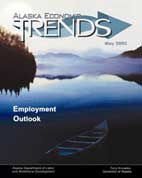
ndustries relying on natural resource development and extraction and those selling Alaska's beauty drive Alaska's labor force. Oil and gas, seafood, and tourism employ a significant share of the state's workforce. In recent years, Alaska's economy has better weathered the storms associated with high and low oil prices, fluctuating fish harvests, and fickle tourists than it did thirty years ago. Today, while the health of resource-based industries still heavily influences the workforce, the state has a more diversified economy.
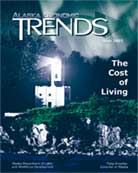
Around the water cooler and in serious circles, Alaska's cost of living has ever been a major source of conversation. Much lore and myth surround the cost of things in Alaska. Although the cost-of-living differential between Alaska and elsewhere in the nation has narrowed, it remains a topic of intense interest, ranking among the most requested economic data. This article is intended to satisfy most of these data needs.

It is not just your imagination that eating places appear to be popping up literally everywhere these days in gas stations, schools, airports, hotels, stores, along with those ubiquitous coffee shacks, and your actual stand-alone fast food eateries, bars, and sit-down restaurants. The eating and drinking industry is mushrooming across the nation.
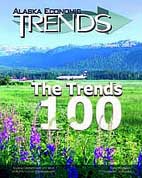
After many years of steady, rapid climb, Providence Health System in Alaska grabbed the top spot on the Trends 100 list in 2001. With a workforce of 3,369, it is now Alaska's largest private sector employer (See Exhibit 1.) Providence's ascendance was anticipated a number of years ago, but was temporarily delayed when Safeway bought Carrs. Ten years ago Providence had a workforce of 1,824.
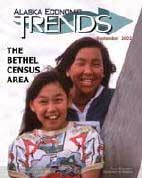
The Bethel census area encompasses a 41,087 square mile area in western Alaska, nearly the size of the state of Ohio. Two types of landscapes predominate. In the southwest lies the vast Yukon-Kuskowim delta region, commonly referred to as the Y-K delta. In this lower section the Kuskokwim River flows southwest and effectively divides the Y-K delta region into a western and eastern half.
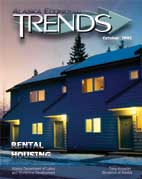
Alaska has a higher proportion of its population living in rental housing than most states, ranking seventh in the U.S., according to Census 2000 figures. About 34 percent of Alaskans live in rental housing. Trends in the residential rental market are of interest to tenants, landlords, banks, developers, and public housing agencies.
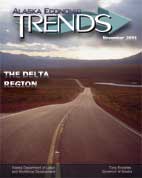
Just seven years ago it looked as if the Delta region were about to lose most of its economic base with the planned closure of Fort Greely. In 1995 it was estimated that nearly half of the economic base in the Delta region was associated with the fort. It was thought that business tied to the Alaska and Richardson highways, the Trans- Alaska Pipeline, transfer payments and farming could sustain a limited amount of economic activity but it certainly would not fill the shoes the Army was about to leave.
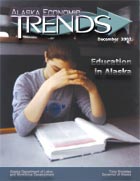
The everyday view of education focuses on the young and what they are learning in school. This article presents an historical perspective of Alaska's population and the changes in the educational profile of generations. Like tree rings, a population's education profile records the climate that affects it. When socio-economic conditions are favorable, educational levels tend to rise. When they are not, this growth is stunted.
